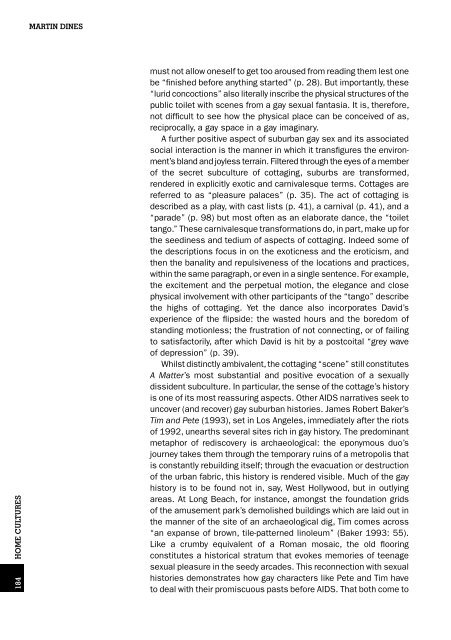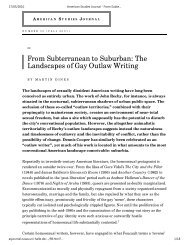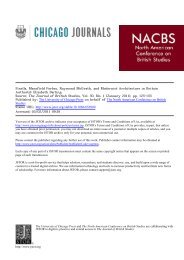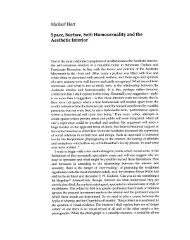sacrilege in the sitting room: contesting suburban ... - Fritz Haeg
sacrilege in the sitting room: contesting suburban ... - Fritz Haeg
sacrilege in the sitting room: contesting suburban ... - Fritz Haeg
You also want an ePaper? Increase the reach of your titles
YUMPU automatically turns print PDFs into web optimized ePapers that Google loves.
HOME CULTURES<br />
184<br />
MARTIN DINES<br />
must not allow oneself to get too aroused from read<strong>in</strong>g <strong>the</strong>m lest one<br />
be “f<strong>in</strong>ished before anyth<strong>in</strong>g started” (p. 28). But importantly, <strong>the</strong>se<br />
“lurid concoctions” also literally <strong>in</strong>scribe <strong>the</strong> physical structures of <strong>the</strong><br />
public toilet with scenes from a gay sexual fantasia. It is, <strong>the</strong>refore,<br />
not difficult to see how <strong>the</strong> physical place can be conceived of as,<br />
reciprocally, a gay space <strong>in</strong> a gay imag<strong>in</strong>ary.<br />
A fur<strong>the</strong>r positive aspect of <strong>suburban</strong> gay sex and its associated<br />
social <strong>in</strong>teraction is <strong>the</strong> manner <strong>in</strong> which it transfigures <strong>the</strong> environment’s<br />
bland and joyless terra<strong>in</strong>. Filtered through <strong>the</strong> eyes of a member<br />
of <strong>the</strong> secret subculture of cottag<strong>in</strong>g, suburbs are transformed,<br />
rendered <strong>in</strong> explicitly exotic and carnivalesque terms. Cottages are<br />
referred to as “pleasure palaces” (p. 35). The act of cottag<strong>in</strong>g is<br />
described as a play, with cast lists (p. 41), a carnival (p. 41), and a<br />
“parade” (p. 98) but most often as an elaborate dance, <strong>the</strong> “toilet<br />
tango.” These carnivalesque transformations do, <strong>in</strong> part, make up for<br />
<strong>the</strong> seed<strong>in</strong>ess and tedium of aspects of cottag<strong>in</strong>g. Indeed some of<br />
<strong>the</strong> descriptions focus <strong>in</strong> on <strong>the</strong> exoticness and <strong>the</strong> eroticism, and<br />
<strong>the</strong>n <strong>the</strong> banality and repulsiveness of <strong>the</strong> locations and practices,<br />
with<strong>in</strong> <strong>the</strong> same paragraph, or even <strong>in</strong> a s<strong>in</strong>gle sentence. For example,<br />
<strong>the</strong> excitement and <strong>the</strong> perpetual motion, <strong>the</strong> elegance and close<br />
physical <strong>in</strong>volvement with o<strong>the</strong>r participants of <strong>the</strong> “tango” describe<br />
<strong>the</strong> highs of cottag<strong>in</strong>g. Yet <strong>the</strong> dance also <strong>in</strong>corporates David’s<br />
experience of <strong>the</strong> flipside: <strong>the</strong> wasted hours and <strong>the</strong> boredom of<br />
stand<strong>in</strong>g motionless; <strong>the</strong> frustration of not connect<strong>in</strong>g, or of fail<strong>in</strong>g<br />
to satisfactorily, after which David is hit by a postcoital “grey wave<br />
of depression” (p. 39).<br />
Whilst dist<strong>in</strong>ctly ambivalent, <strong>the</strong> cottag<strong>in</strong>g “scene” still constitutes<br />
A Matter’s most substantial and positive evocation of a sexually<br />
dissident subculture. In particular, <strong>the</strong> sense of <strong>the</strong> cottage’s history<br />
is one of its most reassur<strong>in</strong>g aspects. O<strong>the</strong>r AIDS narratives seek to<br />
uncover (and recover) gay <strong>suburban</strong> histories. James Robert Baker’s<br />
Tim and Pete (1993), set <strong>in</strong> Los Angeles, immediately after <strong>the</strong> riots<br />
of 1992, unearths several sites rich <strong>in</strong> gay history. The predom<strong>in</strong>ant<br />
metaphor of rediscovery is archaeological: <strong>the</strong> eponymous duo’s<br />
journey takes <strong>the</strong>m through <strong>the</strong> temporary ru<strong>in</strong>s of a metropolis that<br />
is constantly rebuild<strong>in</strong>g itself; through <strong>the</strong> evacuation or destruction<br />
of <strong>the</strong> urban fabric, this history is rendered visible. Much of <strong>the</strong> gay<br />
history is to be found not <strong>in</strong>, say, West Hollywood, but <strong>in</strong> outly<strong>in</strong>g<br />
areas. At Long Beach, for <strong>in</strong>stance, amongst <strong>the</strong> foundation grids<br />
of <strong>the</strong> amusement park’s demolished build<strong>in</strong>gs which are laid out <strong>in</strong><br />
<strong>the</strong> manner of <strong>the</strong> site of an archaeological dig, Tim comes across<br />
“an expanse of brown, tile-patterned l<strong>in</strong>oleum” (Baker 1993: 55).<br />
Like a crumby equivalent of a Roman mosaic, <strong>the</strong> old floor<strong>in</strong>g<br />
constitutes a historical stratum that evokes memories of teenage<br />
sexual pleasure <strong>in</strong> <strong>the</strong> seedy arcades. This reconnection with sexual<br />
histories demonstrates how gay characters like Pete and Tim have<br />
to deal with <strong>the</strong>ir promiscuous pasts before AIDS. That both come to








